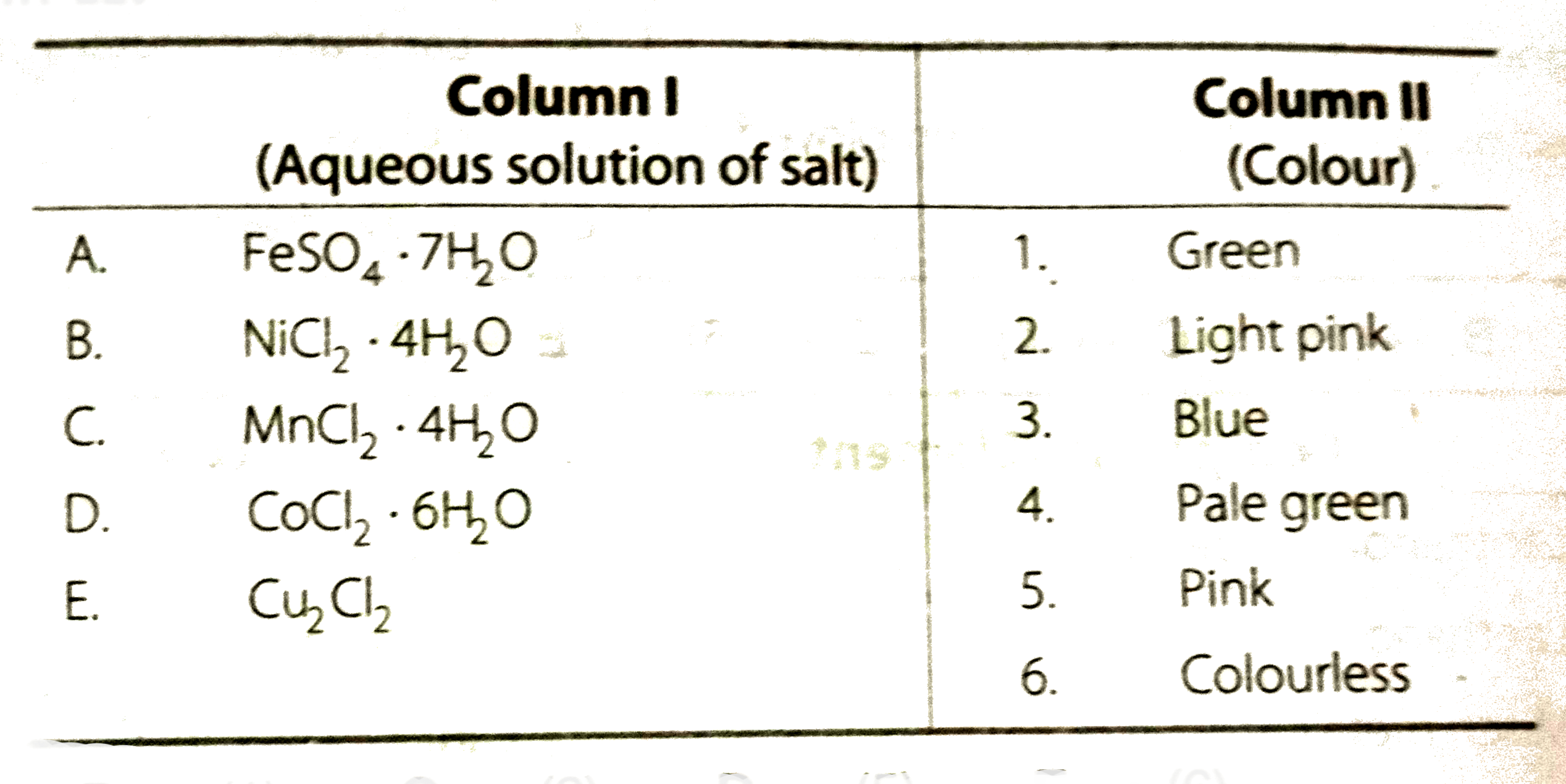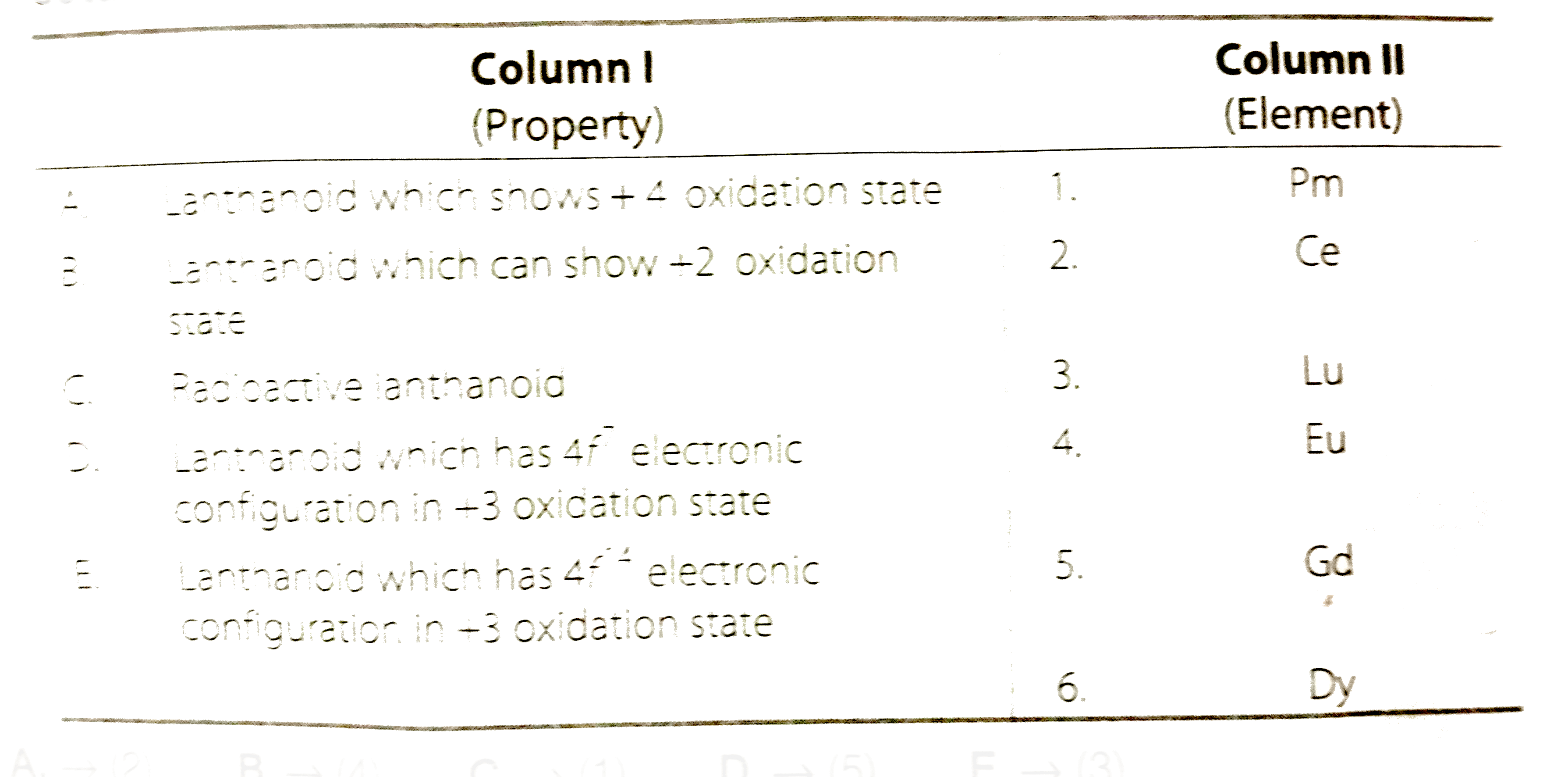Complete Solutions to D And F-Block Elements of chapter D AND F-BLOCK ELEMENTS of Class 12 book with complete answers and questions
| Class 12 | CHEMISTRY |
| Chapter | D AND F-BLOCK ELEMENTS |
| NCERT EXEMPLAR | D And F-Block Elements |
| Number Of Questions | 71 |
| Academic Year | 2023-24 |
Electronic confriguration of a transition element X in +3 oxidation states is `[Ar]3d^(5)`.
What is its atomic number?
View SolutionThe electronic configurationo of Cu(II) is `3d^(9)` whereas that of Cu(I) is `3d^(10)`. Which of the following is correct ?
View SolutionMetallic radii of some transitions element are given below. Which of these elements will have highest density ?
`{:("Element",Fe,Co,Ni,Cu),("Metallic",126,125,125,128),("radii/pm",,,,):}`
View SolutionGenerally transition elements from coloured salts due to the presence of unpaired electrons. Which of the following compounds will be coloured in solid state?
View SolutionOn addition of small amoung of `KMnO_(4)` to concentrated `H_(2)SO_(4)`, a green oily compound is obtained which is highly explosive in nature. Identify the compound from the following.
View SolutionThe magnetic nature of elements depends on the presence of unpaired electrons. Identify the configuration of transition element, which shows highest magnetic moment.
View SolutionWhich of the following oxidation states is the most common among the lanthanoids ?
View SolutionWhich of the following reactions are disproportionation reactions?
`(A)" " Cu^(+)rarrCu^(2+)+Cu`
`(B)" "3 MnO_(4)^(2-)+4H^(+)rarr2MnO_(4)^(-)+MnO_(2)+2H_(2)O`
`(C )" "2KMnO_(4)rarrK_(2)MnO_(4)+MnO_(2)+O_(2)`
`(D)" "2MnO_(4)^(-)+3Mn^(2+)+2H_(2)O rarr5MnO_(2)+4H^(+)`
View SolutionWhen `KMnO_(4)` solution is added to oxalic acid solution , the decolourisation is slow in the beginning but becomes instantaneous after some time because
View SolutionThere are 14 elements in actinoid series. Which of the following elements does not belong to this series?
View Solution`KMnO_(4)` acts as an oxidising agent in acidic medium. The number of moles of `KMnO_(4)` that will be needed to react with one mole of sulphide ions in acidic solution is
View SolutionWhich of the following is amphoteric oxide?
`Mn_(2)O_(7),CrO_(3),Cr_(2)O_(3),CrO,V_(2)O_(5),V_(2)O_(4)`
View SolutionGadolinium belongsd to 4f series. It's atomic number is 64. which of the following is the correct electronic configuration of gadolinium ?
View SolutionInterstitial compounds are formed when small atoms are trapped inside the crystal lattice of metals. Which of the following are the characteristic properties of interstitial compounds?
I. They have high melting points in comparison to pure metals.
II. They are very hard.
III. They retain metallic conductivity.
IV. They are chemically very reactive.
View SolutionThe magnetic moment is associated with its spin angular momentum and orbital angular momentum. Spin only magnetic moment value of `Cr^(3+)` ion is
View Solution`KMnO_(4)` acts as on oxidising agent in alkaline medium. When alkaline `KMnO_(4)` is treated with `KI`, iodide ion is oxidised to `…………….`
View SolutionWhich of the following statements is not correct?
View SolutionWhen acidified `K_(2)Cr_(2)O_(7)` solution is added to `Sn^(2+)` salts then `Sn^(2+)` changes to
View SolutionHigher oxidation state of manganese in fluoride is `+4 (MnF_(4))` but highest oxidation state in oxides is `+7(Mn_(2)O_(7))` because
View SolutionAlthough zirconium belongs to 4d transition series and hafnium to 5d transition series even then they show similar physical and chemical properties because …….. .
View SolutionWhy HCl not used to make the mdeium acidic in oxidation reactions of `KMnO_(4)` in acidic medium ?
View SolutionGenerally transition elements and their salts are coloured due to the presence of unpaired electrons in metal ions. Which of the following compounds are coloured?
View SolutionTransition elements show magnetic moment due to spin and orbital motion of electrons. Which of the following metallic ions have almost same spin only magnetic moment?
View SolutionIn the form of dichromate, Cr(VI) is a strong oxidising agent in acidic medium but Mo(VI) in `Mo0_(3)` and W(VI) in `W0_(3)` are not because
View SolutionWhich of the following actinoids show oxidation states upto +7?
View SolutionGeneral electronic configuration of actinoids is `(n-2)f^(1-14)(n-1)d^(0-2)ns^(2)`. Which of the following actinoids have one electron in 6d orbital?
View SolutionWhich of the following lanthanoids show `+2` oxidation state besides the characteristic oxidation state +3 of lanthanoids?
View SolutionWhich of the following ions show higher spin only magnetic moment value?
View SolutionTransition elements form binary compounds with halogens. Which of the following elements will form `MF_(3)` type compounds?
View SolutionWhich of the following will not act as oxidising agents?
View SolutionAlthough `+3` is the characteristic oxidation state for lanthanoids but cerium also shows `+4` oxidation state because
View SolutionWhy does copper not replace hydrogen from acids?
View SolutionWhy `E^(-)` values for Mn, Ni and Zn are more negative than expected?
View SolutionWhy first ionisation enthalpy of Cr is lower than that of Zn?
View SolutionTransition elements show high melting points. Why?
View SolutionWhen `Cu^(2+)` ion is treated with KI, a white precipitate is formed. Explain the reaction with the help of chemical equation.
View SolutionOut of `Cu_(2)Cl_(2)` and `CuCl_(2)`, which is more stable and why?
View SolutionWhen a brown compound of manganese (A) is treated with HCl it gives a gas (B). The gas taken in excess, reacts with `NH_(3)` to give an explosive compound (C ). Identify compound A, B and C.
View SolutionAlthough fluorine is more electronegative than oxygen, but the ability of oxygen to stabilise higher oxidation states exceeds that of fluorine. Why?
View SolutionAlthough `Cr^(3+)` and `Co^(2+)` ions have same number of unpaired electrons but the magnetic moment of `Cr^(3+)` is `3.87 B.M`. and that of `Co^(2+)` `4.87` B.M. because….
View SolutionIonisation enthalpies of Ce, Pr and Nd are higher than Th, Pa and U. Why?
View SolutionAlthough Zr belongs to 4d and Hf belongs to 5d transition series but it is quite difficult to separate them, Why?
View SolutionCerium shows oxidation state of `+4` because
View SolutionExplain why does colour of `KMnO_(4)` disappear when oxalic acid is added to its solution in acidic medium?
View SolutionWhen orange solution containing `Cr_(2)O_(7)^(2-)` ion is treated with an alkali, a yellow solution is formed and when `H^(+)` ions are added to yellow solution, an orange solution is obtained. Explain why does this happen?
View SolutionA solution of `KMnO_(4)` on reduction yields either a colourless solution or a brown precipitate or a green solution depending on pH of the solution. What different stages of the reduction do these represent and how are they carried out ?
View SolutionThe second and third rows of transition elements resemble each other much more than they resemble the first row. Explain, why?
View Solution`E^(Theta)` of Cu is +0.34V while that of Zn is -0.76 V. Explain.
View SolutionThe halides of transition elements become more covalent with increasing oxidation state of the metal. Why?
View SolutionWhile filling up of electrons in the atomic orbitals, the 4s orbital is filled before the 3d orbital but reverse happens during the ionisation of the atom. Explain why?
View SolutionReactivity of transition elements decreases almost regularly from Se to Cu. Explain.
View SolutionMatch the catalyst given in Column I with the processes given in Column II.

View SolutionMatch the compounds/elements given in Column I with uses given in Column II.

View SolutionMatch the properties given in Column I with the metals given in Column II

View SolutionMatch the statements given in Column I with the oxidation states given in Column II.

View SolutionMatch the solutions given in Column I and the colours given in Column II.

View SolutionMatch the property given in Column I with the element given in Column II.

View SolutionMatch the properties given in Column I with the metals given in Column II.

View SolutionAssertion (A) `Cu^(2+)` iodine is not known.
Reason (R ) `Cu^(2+)` oxidises `I^(-)` to iodine.
View SolutionAssertion (A) Separation of Zr and Hf is difficult.
Reason (R ) Because Zr and Hf lie in the same group of the Periodic Table.
View SolutionAssertion (A) Actinoids form relatively less stable complexes as compared to lanthanoids.
Reason (R ) Actinoids can utilise their 5f orbitals alongwith 6d orbitals in bonding but lanthanoids do not use their 4f orbital for bonding.
View SolutionAssertion (A) Cu cannot liberate hydrogen from acids.
Reason (R ) Because it has positive electrode potential.
View SolutionAssertion (A) The highest oxidation state of osmium is +8.
Reason (R ) Osmium is a 5d-block element.
View SolutionIdentify A to E and also explain the reaction involved.

View SolutionWhen a chromite ore (A) is fused with sodium carbonate in free excess of air and the product is dissolved in water, a yellow solution of compound (B) is obtained. After treatment of this yellow solution with sulphuric acid, compound (C ) can be crystallised from the solution. When compound (C ) is treated with KCl, orange crystals of compound (D) crystallise out. Identify A to D and also explain the reactions.
View SolutionWhen an oxide of manganese (A) is fused with KOH in the presence of an oxidising agent and dissolved in water, it gives a dark green solution of compound (B). Compound (B) disproportionates in neutral or acidic (C ) oxidises potassium iodide solution to a compound (D) and compound (A) is also formed. Identify compounds A to D and also explain the reactions involved.
View SolutionOn the basis of lanthanoid contraction, explain the following:
(i) Nature of bonding in `La_(2)O_(3)` and `Lu_(2)O_(3)`.
(ii) Trends in the stability of oxo salts of lanthanoids from La to Lu.
(iii) Stability of the complexes of lanthanoids.
(iv) Radii of 4d and 5d block elements.
(v) Trends in acidic character of lanthanoids oxides.
View SolutionAnswer the following questions
(i) Which element of the first transition series has highest second ionisation enthalpy?
(ii) Which element of the first transition series has highest third ionisation enthalpy?
(iii) Which element of the first transition series has lowest enthalpy of atomisation?
(b) Identify the metal and justify your answer.
(i) Carbonyl `M(CO)_(5)`
(ii) `MO_(3)F`
View SolutionMention the type of compounds formed when small atoms like H, C and N get trapped inside the crystal lattice of transition metals. Also give physical and chemical characteristics of these compounds.
View Solution(a) Transition metals can act as catalysts because these can change their oxidation state. How does Fe (III) catalyse the reaction between iodide and persulphate ions?
(b) Mention any three processes where transition metals act as catalysts.
View SolutionA violet compound of manganese (A) decomposes on heating to liberate oxygen and compounds (B) and (C ) of manganese are formed. Compound (C ) reacts with KOH in the presence of potassium nitrate to give compound (B). On heating compound (C ) with conc. `H_(2)SO_(4)` and NaCl, chlorine gas is liberate and a compound (D) of manganese alongwith other products is formed. Identify compounds A to D and also explain the reaction involved.
View Solution
D And F-Block Elements questions and complete solutions for chapter D AND F-BLOCK ELEMENTS of CHEMISTRY of Class 12